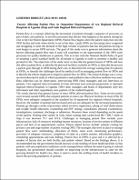| dc.description.abstract | GIHEMBO BRIDGET (2012-M191-10010)
Factors Affecting Patient Flow in Outpatient Departments of two Regional Referral Hospitals in Uganda (Jinja and Gulu Regional Referral Hospitals)
Patient flow is a concept reflecting the movement of patients through a sequence of processes as part of their care pathway. It involves processes that dictate what happens to the patient during his visit to the Out Patient department (OPD). Patient flow begins when the patient steps foot into the OPD facility and ends when she/he is out of the door. Lately OPDs are becoming more congested and struggling to meet the demand of the high volume of patients that has led patients having to wait longer to access OPD services. The goal of this study was to generate information about the factors affecting patient flow that if used will contribute to the improvement of the OPD work processes for quality healthcare to patients. This is in line with the National Health Policy II goal of attaining a good standard health for all people in Uganda in order to promote a healthy and productive life. The objectives of the study were: to describe the general layout of OPDs and how this affects patient flow, to identify the physical facilities available in OPDs, to describe the process a patient goes through in OPD during their care, to determine the average waiting time for patients in OPDs, to identify the challenges faced by medical staff in managing patient flow in OPDs and to identify the efforts employed to improve patient flow in OPDs. The research design was a cross-sectional descriptive study in which quantitative and qualitative data collection methods were used. Data collection was by observation, interviewing OPD clinic managers and exit interviews to patients. Two regional referral hospitals of Gulu and Jinja were selected purposively to represent regional referral hospitals in Uganda. OPD clinic managers and heads of departments were key informants and other respondents were patients of the studied hospitals.
The results showed that general layout of most OPDs affected patient flow. Some service points were located outside OPDs that required patients to move out. Physical facilities in most of the 20
OPDs were adequate compared to the standard list of equipment for regional referral hospitals; however, the number of patients had increased and was not adequate for the increased population. Patients go through a series of processes which involves registration, taking of vital observations and weight, health education, counselling and HIV testing, consultation, physical examination, investigations, treatment, discharge or admission. However these varied depending on the needs of the patient. Waiting time varied; in Gulu, mean waiting time varied from 88.7-300.7 while in Jinja it was between 75.7 and 241.6. Challenges in managing patient flow include: poor infrastructure, lack of resources including human resources, location of service points in different places and lack of an appointments system. Patient related factors include: patients coming for primary care and large number of patient visiting OPD. The strategies that were in place to manage patient flow were: multitasking, allocation of duties, team work, monitoring performance, provision of adequate resources, completion of tasks in a timely manner, information graphics, scheduling appointments and task shifting. Patient flow in OPDs is poor and it is affected by a number of factors that are both facility and patient related. Based on the findings above, it is recommended that the government should increase on the funding of lower health facilities so that patients with uncomplicated conditions can be managed there without the need of going to referral hospitals, the government should consider on improving on the infrastructure to cater for the growing demand for health care, there is need to revise the staffing levels of health facilities to match the growing population of patients.
Key Words: Factors, Affecting, Patient, Flow, Outpatient Departments, Regional Referral Hospitals, Jinja, Gulu. | en_US |


